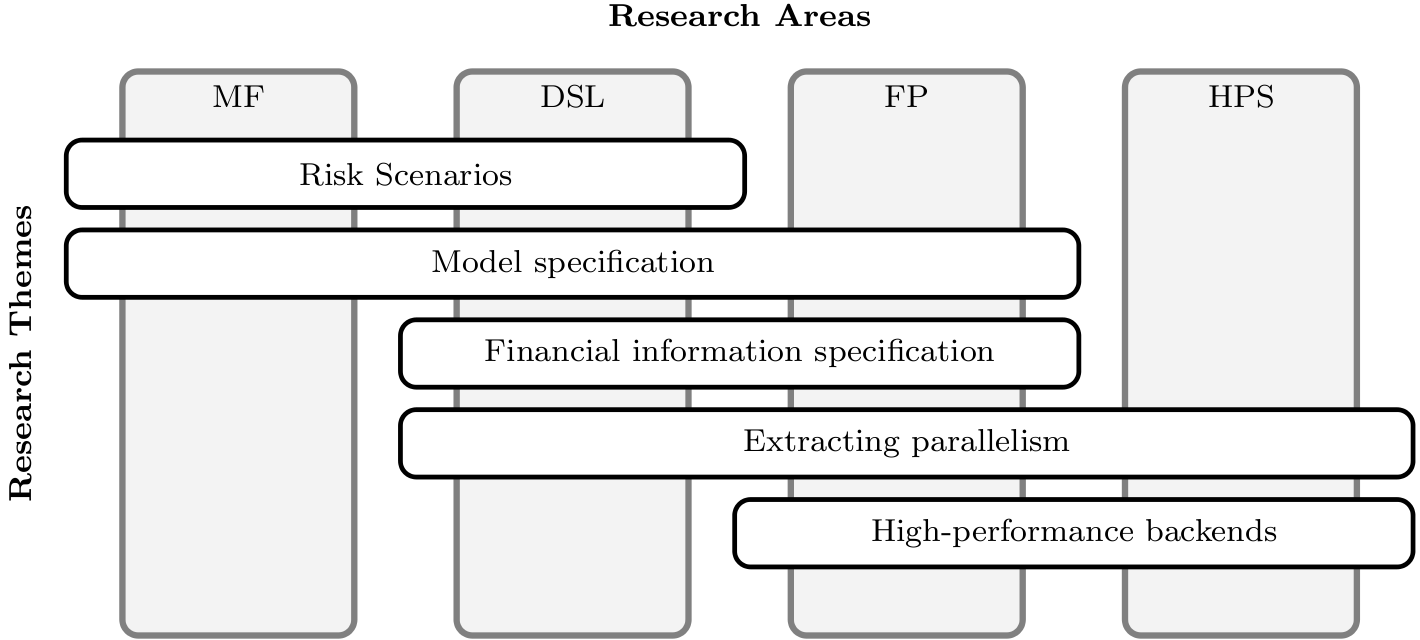Research
Research in HIPERFIT follows a paradigm of project-driven research theme exploration.
Research projects are concrete cases for exploration and development, either motivated by practical needs of industry partners (problem-driven), or by the intent to evaluate novel technologies and gather know-how for later use (technology driven). Projects may or may not contain information protected by industry partners.
Experience and lessons from our work on projects directs our work on research themes, cross-cutting several research areas within computing for finance, generally leading to open publishable results. Projects help identify useful and timely goals, while research themes provide the headroom and freedom which is necessary for true innovation.
The relation between research themes and research areas are outlined in the following diagram:

The various research areas are described below; more information is available on the research themes page.
Mathematical Finance
TODO
Domain-Specific Languages
Declarative domain-specific languages (DSLs) capture knowledge of application experts in tailor-made constructs and thereby offer great programing comfort, operating at a high level of (programming) abstraction. DSLs are so widespread and successful in practice that it is easy to overlook them. Examples of DSLs in use are: query languages for relational database systems; spreadsheets involving circular dependencies and incremental recomputation; or regular expression and context-free grammars used in compiler construction tools.
Financial applications have been identified as a promising DSL area relatively early. Researchers have successfully modelled and analysed financial instruments , commercial contracts, and risk management using DSL technology. DSLs for financial instruments are today commonly used in many companies, but often mix contract and valuation aspects. A crucial goal of HIPERFIT is to design similarly expressive languages to describe the valuation process (possibly using probabilistic computation and simulation), and to achieve clear separation and interfaces towards a universal valuation engine.
Parallel Functional Programming
It has been stated numerous times that (parallel) functional programming has fundamental advantages over an imperative programming model (see the seminal paper by John Hughes and the book by Hammond and Michaelson). Functional programs are much easier to read and understand, program construction and code reuse are simplified (glue), and programs are transformed, optimised and formally reasoned about with ease. More specific to parallel computations, absence of side effects makes data dependencies and inherent parallelism manifest, (purely) functional parallel programs are deterministic irrespective of the evaluation order, and reduction semantics is inherently parallel, to start with. Last but not least, higher-order functions can nicely describe common parallelisation patterns as skeletons, without getting lost in technical details or particularities of the concrete algorithm. In all, irrespective of the concrete programming model, the high abstraction provided by functional languages makes them suitable languages to conceptually describe parallelism, in an executable specification.
Within HIPERFIT, we aim to develop a functional language that can be productively used to express computations in mathematical finance, and which exposes inherent parallelism in these computations. Driven by the concrete application domain of financial modeling, we will identify common computation patterns and their potential for parallelisation. Potentially parallel computations should be easy to extract and transform into explicitly parallel operations on a variety of modern parallel platforms.
High-Performance Systems
TODO
 HIPERFIT
HIPERFIT